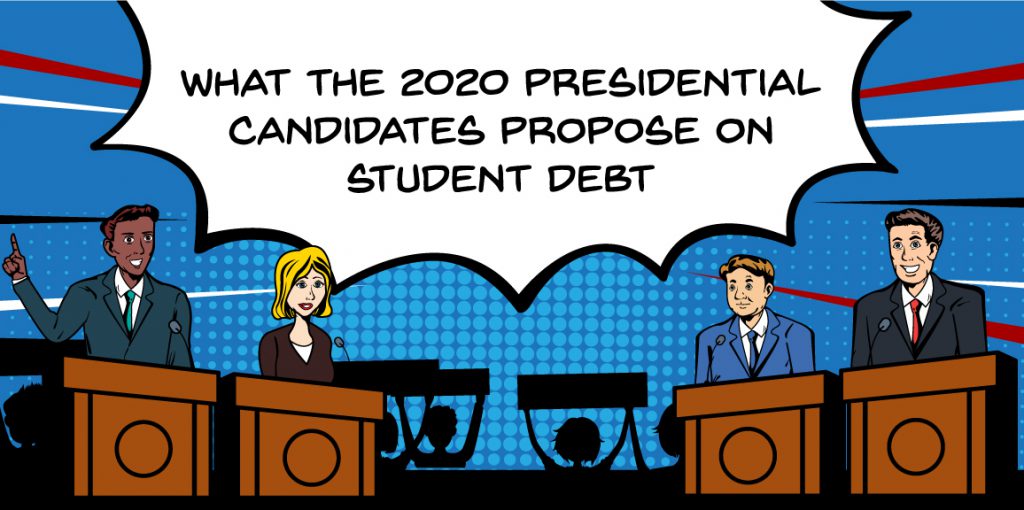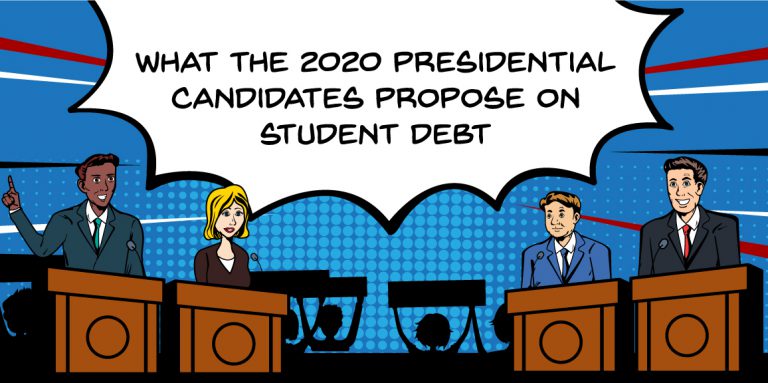With more than 20 Democrats and one Republican running to succeed President Trump, a lot of ideas and promises have been floated by the candidates.
One of the biggest issues discussed as the race has heated up is what to do about student debt. Almost every candidate has a plan or has at least shared their thoughts on how to reduce the crippling burden of borrowing ever-larger amounts of money to pay for college.
As a voter, it’s not always easy to understand and compare what each candidate stands for. To help, we’ve put together a summary of what most of the 2020 presidential candidates have proposed regarding college education and student loans, giving you enough background to make a more informed decision before voting in the primaries.
Why student loan debt is a hot issue in the 2020 campaign
Regardless of which side of the aisle you’re on, the student loan debt crisis is real and it’s growing. According to the Institute for College Access & Success, 65% of college seniors who graduated in 2017 were carrying student loans, with an average balance of $28,650. In total, Americans owe nearly $1.6 trillion in student loan debt, more than the all credit card debt in the U.S., and triple the total amount of student loans in 2005.
That burden has had a significant — and sometimes devastating — impact on student loan borrowers. In a 2018 survey by Student Debt Crisis, called Buried in Debt, 80% of respondents said student loans prevented them from being able to save for retirement, and roughly two-thirds reported having less than $1,000 in their bank account, partly because of their high student loan payments. Among the negative impacts, more young adults have delayed buying homes or starting families compared to previous generations.
It’s not just financial stress that student loan borrowers suffer, either. According to a 2017 survey by Student Loan Hero, 50% or more respondents reported experiencing depression, anxiety, headaches, loss of sleep and more.
Some might blame individual student borrowers for their plight, and it is true that the loans weren’t forced upon them. But the context of the student loan debt crisis paints a clearer picture of how the U.S. has gotten to this point.
Exponential increases in tuition
The cost of a college education has increased exponentially over the last few decades, putting today’s college graduates at a large financial disadvantage the moment they leave school.
According to the 2018 Trends in College Pricing study by the College Board, the average published annual tuition and fees for a public four-year university for the 1988-1989 school year were $3,360 in 2018 dollars. For the 2018-2019 school year, the average was more than three times as high at $10,230.
And those amounts don’t cover the total cost of attendance, which also includes books, room and board, transportation and other expenses.
By a factor of two or three, college is significantly more expensive than it was for previous generations. And while it’s still possible to reduce how much you borrow by applying for scholarships and grants, picking an inexpensive school and working more hours, it’s getting harder and harder to eliminate the need for student loans entirely.
Ease of approval
To help students cope with the costs of a college education, the U.S. Department of Education provides access to federal financial aid in the form of grants and student loans. And unlike loans from traditional lenders, federal student loans are incredibly easy to get.
If you’re an undergraduate or graduate student, for example, you can qualify for Direct Subsidized or Unsubsidized Loans without undergoing a credit check. And while there are limits on how much you can borrow each term and in total, it’s easy for college students to borrow even more than they actually need.
Mixed signals
Even when incoming college students have a fair understanding of how student loans work, it’s still not easy for them to get the full picture. According to a 2018 report by the ‘think tank’ New America, called Decoding the Cost of College, financial aid award letters can be confusing.
Here are just a few findings from that study:
- More than 450 colleges that offered Direct Unsubsidized Student Loans used 136 different terms to describe the loan they offered, and 24 of them didn’t even include the word —loan.”
- More than a third of financial aid award letters didn’t provide any information to help students understand what student loans would actually cost them.
- Seven in 10 award letters grouped all federal financial aid into one bucket, giving no information about the differences between scholarships, grants, loans and work-study programs.
Without a full picture of what they’re getting, it’s virtually impossible for students to make good decisions regarding the cost of their schooling.
A lack of counseling
Taking out a student loan is an individual and sometimes family choice. But it can be difficult for teenagers and young adults to make good decisions on financing their education without truly understanding the obligations they are taking on.
The Department of Education makes it easy to get approved for student loans, but there are no requirements or standards for students to get financial advice or counseling before they commit. Or after.
If the colleges or federal government were to require that students meet with a qualified, third-party counselor before signing the dotted line — something that is required for senior citizens interested in getting a government-insured reverse mortgage — and learn about their alternatives, it could reduce the need for student loans.
Proposals from 2020 presidential candidates
Millennials and Gen Z-ers are estimated to make up 37% of the 2020 electorate, according to the Pew Research Center. So, it’s almost a requirement for presidential candidates to address the student loan debt crisis in one way or another.
Many of them have plans for how to tackle existing student loan debt, the cost of a college education or both. Here’s a list of presidential candidates in alphabetical order and what they’ve proposed so far.
Michael Bennet
The Senator from Colorado hasn’t proposed anything to address existing student loan debt. However, he has emphasized the importance of providing alternatives to college that can provide a high-quality education at a lower cost.
He also supports the expansion of year-round Pell Grants to provide more aid to low-income students and a solution to simplify the financial aid process.
Joe Biden
Former Vice President Joe Biden hasn’t announced any formal plan to tackle student debt. However, he did say in 2015 that he supported making public college education free for students.
He also has plans to fix the Public Service Loan Forgiveness program (PSLF), focusing on helping teachers attain forgiveness for their student debt. But there are no specifics on how he’ll achieve this goal.
Cory Booker
The New Jersey Senator has taken several positions on the issue of student debt. In 2018, he co-sponsored the Debt-Free College Act, which would help provide debt-free college for students at certain schools and make federal financial aid available to ‘Dreamer’ students and students convicted for the possession or sale of illegal drugs.
Earlier this year, he also proposed a government-run ‘baby bond’ savings program that would provide every child born in the U.S. with $1,000 plus up to $2,000 every year after that, based on the family’s income, to help them pay for college.
Booker also supports ideas to simplify the student loan process and allow students to refinance their loans.
Steve Bullock
The Montana governor has stated he believes the country should help make college more affordable but hasn’t provided any specifics on how to accomplish this. In his own state, Bullock signed a law designed to provide student loan repayment assistance to farmers.
Pete Buttigieg
The mayor of South Bend, Indiana, focuses his proposals on making college more affordable or even free for low-income families, primarily through state-federal partnerships and large increases to the Pell Grant program.
Julián Castro
Former Housing Secretary Castro has offered many proposals regarding student loan debt, including:
- Eliminating tuition at public colleges and universities, community colleges, and technical and vocational schools
- Lowering student loan payments for borrowers with a household income below 250% of the poverty line to as little as $0
- Providing non-taxable student loan forgiveness after 20 years
- Capping the amount of interest that can accumulate on a student loan balance
- Expanding the Pell Grant program
- Creating a new forgiveness program for low-income borrowers
- Allowing borrowers to discharge student loans in bankruptcy
- Providing more federal support to historically black colleges and universities and other minority-serving institutions
- Reforming Public Service Loan Forgiveness to make it fairer to eligible borrowers
- Requiring universities to certify private student loans
Bill de Blasio
The current mayor of New York City has not announced any plans to address student loan debt or the cost of a college education.
John Delaney
In addition to supporting tuition-free community colleges, the former Congressman from Maryland also wants to allow borrowers to discharge federal and private student loans in bankruptcy. He also supports reducing the overall cost of college education and providing more federal grant money to low-income students.
Tulsi Gabbard
The Congresswoman from Hawaii has proposed not only to cut federal student loan interest rates in half, but also to allow existing borrowers to refinance their balances at the new, lower rates.
Additionally, Gabbard co-sponsored a House version of Senator Bernie Sanders’ College for All Act. The bill proposes to eliminate undergraduate tuition at all four-year public colleges and universities, drop interest rates by almost half, allow refinancing within the federal loan program, and eliminate the requirement for students to re-apply for federal financial aid every year.
Kirsten Gillibrand
Like Senator Booker, New York Senator Gillibrand co-sponsored the 2018 Debt-Free College Act. She also supports allowing federal student loan borrowers to refinance their loans at a 4% interest rate and supports tuition-free community colleges for all and tuition-free public colleges for low-income students.
Kamala Harris
Another co-sponsor of the 2018 Debt-Free College Act, California Senator Harris has also proposed allowing federal student loan borrowers to refinance their loans at lower interest rates, expanding the income-based repayment plan to more borrowers, and cracking down on for-profit colleges (which the Senator did when she sued Corinthian Colleges as California’s attorney general).
Harris also supports the concept of free community colleges and debt-free four-year public colleges.
John Hickenlooper
The former governor of Colorado doesn’t have any formal plans in place, but has said in interviews that he supports lowering student loan interest rates to 2.5% or even lower, if possible.
Jay Inslee
The Washington state governor hasn’t announced any plans to tackle the student debt crisis nationally. But in his home state, he proposed a plan called the College Promise grant, which would provide greater financial aid to more than 93,000 low-income college students in the state.
Amy Klobuchar
When Klobuchar was a newly-elected Senator in 2007, she supported the College Cost Reduction Act, which created Public Service Loan Forgiveness, cut federal student loan interest rates, created income-based repayment plans, and increased funding for Pell Grants.
Then in 2009, she supported the American Opportunity Tax Credit, which provides college students and their families with up to $2,500 in tax credits for qualified higher education expenses for their first four years in school.
During her 2020 presidential campaign, Klobuchar has stated that she supports further expanding Pell Grants, providing tuition-free community, technical and tribal colleges, allowing federal loan borrowers to refinance at lower interest rates and curbing further interest rate increases.
Beto O’Rourke
The Texas Congressman hasn’t provided any specifics on his plan to tackle student loan debt since announcing his decision to run for president. In the past, however, he has supported loan forgiveness for borrowers who work in under-served communities, tuition-free community colleges, and working with colleges to curb tuition inflation.
O’Rourke also believes that student loan borrowers should be able to refinance older federal debt at today’s lower interest rates.
Tim Ryan
The Ohio Congressman supports tuition-free community colleges and free public college tuition for certain low-income students. It’s not all talk, either. Ryan has been a co-sponsor on the House version of the College for All Act, the Aim Higher Act and the Debt-Free College Partnerships Act.
All three of these acts aim to reduce the cost of college and provide more protections for college students.
Bernie Sanders
While most 2020 presidential candidates have recently come out in support of taking tangible steps to address the student loan crisis, Senator Sanders announced in 2015 his intention to offer two free years of college — either at community college or a public four-year university — to every college student.
Since then, Sanders has stepped up his proposal to include canceling student loan debt for all student loan borrowers and passing his College for All Act, which would eliminate tuition and fees at four-year colleges and universities, community and tribal colleges, trade schools and apprenticeship programs.
Other proposals Sanders has embraced include increasing access to Pell Grants, capping student loan interest rates at 1.88%, tripling funding for the federal work-study program, and providing more government investment in historically black colleges and universities and other minority-serving institutions.
The Senator plans to fund his proposals by levying a tax on certain financial transactions, including trades of stocks, bonds and derivatives.
Donald Trump
The president signed a bill in 2017 that restored year-round access to Pell Grants but also proposed earlier this year to shift surplus money from the Pell Grant fund to other budget needs.
To combat tuition inflation, President Trump also proposed setting lower limits on federal student loans, thereby reducing the supply of money available to students to pay higher costs.
Other proposals the Trump administration has made include reducing income-driven repayment plan options from four to one to simplify the process, eliminating Public Service Loan Forgiveness, and enhancing student loan forgiveness for all borrowers through an income-driven repayment plan.
Elizabeth Warren
In addition to being a co-sponsor on the Debt-Free College Act, the Massachusetts Senator:
- Supports free tuition for all students at public colleges
- Proposes to cancel student loan debt for all borrowers with a household income under $100,000
- Believes the federal government should allow borrowers to refinance their loans without needing to work with a private lender and give up federal benefits
- Wants to make sure the federal government doesn’t receive any profits from providing student loans
Warren has stated that she would support increasing taxes on wealthy citizens to pay for her proposals.
Bill Weld
The former Massachusetts governor, who is running against President Trump in the Republican primaries, wants to repeal the provision in federal law that doesn’t allow students to renegotiate their federal student loan debt.
Weld has also called for an increased focus on online education, which can increase access to college courses for citizens who may not be able to afford to attend full-time or in-person.
Marianne Williamson
The self-help guru supports free tuition for college and technical schools for qualified students, though she doesn’t specify how a student would be deemed eligible. Williamson also proposes to:
- Eliminate annual caps on subsidized federal loans
- Get rid of the loan fee on all federal student loans
- Reduce the repayment requirement for Public Service Loan Forgiveness from 10 years to five years
- Cut interest rates to a nominal figure, or even 0%, if possible.
Andrew Yang
The former tech executive has proposed a very specific plan, where student loan borrowers who pledge 10% of their salary for 10 years toward repayment would receive forgiveness on the remaining balance once they reach the 10-year mark.
Other ideas Yang has advocated include:
- Ensuring the federal government receives no profits from the federal loan program
- Asking schools to forgive some or all of the debts incurred by students who don’t graduate
- Changing bankruptcy laws to make it easier to discharge student loan debt
- Making it easier for graduates who work in rural areas or with underprivileged populations to attain loan forgiveness
How likely are any of these proposals to pass?
There are a lot of ideas being put on the table by 2020 presidential candidates, and while some have provided specifics on how they plan to pay for them, others haven’t.
In the cases of Senators Sanders and Warren, for instance, increasing taxes on the wealthy directly or indirectly through financial transaction taxes is the way they would fund their proposals. But these ideas have drawn criticism from across the aisle and somewhat less than full-throated support from centrists in their own party and will have to compete with other top priorities. In any event they are unlikely to become law without a Democrat-controlled Congress and a Democrat in the White House.
If they do get signed, however, lowering or canceling student loan debt for millions of borrowers would act as an economic stimulus package, providing consumers with more money to spend instead of recycling so much money toward federal student debt.
Some of the less-comprehensive and less-expensive proposals would likely also face opposition from Republican lawmakers, but may be more realistic candidates for bipartisan support in an evenly divided Congress.
As the 2020 presidential candidates continue to make their case and primary voters make their decisions on who will be nominated, we’ll gain a better idea of which student loan proposals have legs and which ones do not.
















